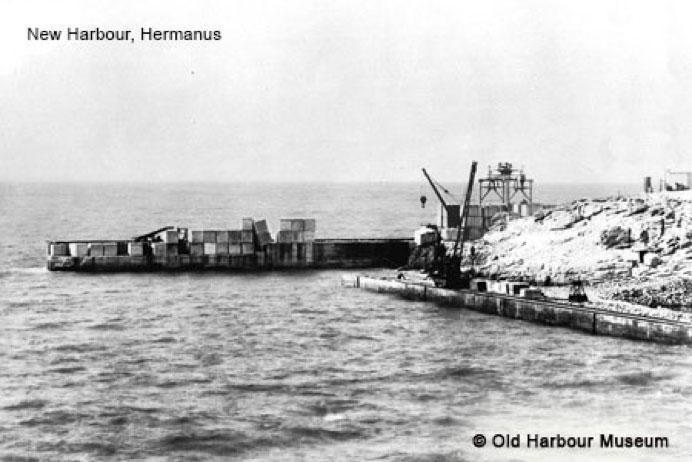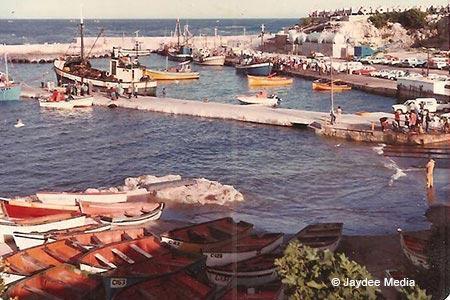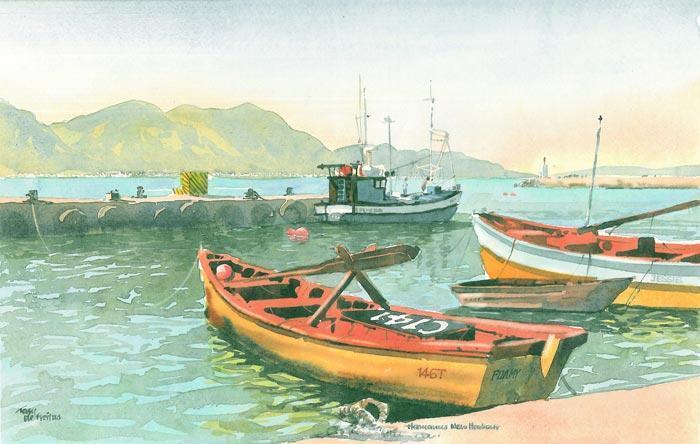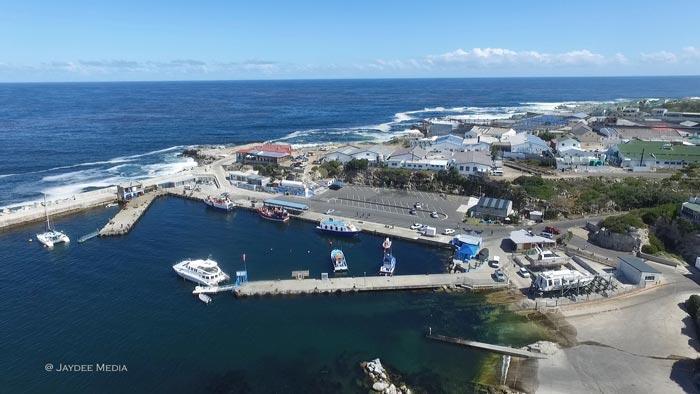History of the Hermanus New Harbour
During the 1920’s it become clear that the Hermanus Old Harbour was too small to accommodate the number of fishing boats using it, and they asked the then harbour master, Mr H R Hall, to prepare a report recommending a site for a larger harbour. The small cove he recommended to build the new harbor was known as “Still Bay”.
 The plans were put into action to build a new harbour. These plans were put on halt as there was no funding available during what became known as the Great Depression of the 1930’s. It was only in 1939 that they could start with the construction of the southern breakwater (the present one), which again had to be placed on hold when a global war, known as World War II, broke out in 1939 and lasted until August 1945.
The plans were put into action to build a new harbour. These plans were put on halt as there was no funding available during what became known as the Great Depression of the 1930’s. It was only in 1939 that they could start with the construction of the southern breakwater (the present one), which again had to be placed on hold when a global war, known as World War II, broke out in 1939 and lasted until August 1945.
Photo courtesy of the Old Harbour Museum
 By the end of 1946 the southern breakwater was done, and it was only about ten years later, in 1951 that the new harbour, with its sharp cut into the sea from the headland where the factories today stand, was completed and fully operational. Throughout its construction though, it had been used by trawlers and other boats and it also provided an excellent fishing zone. Most of the fisherman who used the Old Harbour moved across to the New Harbour. Photo from Eric and Lana Small
By the end of 1946 the southern breakwater was done, and it was only about ten years later, in 1951 that the new harbour, with its sharp cut into the sea from the headland where the factories today stand, was completed and fully operational. Throughout its construction though, it had been used by trawlers and other boats and it also provided an excellent fishing zone. Most of the fisherman who used the Old Harbour moved across to the New Harbour. Photo from Eric and Lana Small
However, over-fishing by boats and trawlers from outside the Walker Bay area drastically reduced the catches of fish. In practical terms, the trawlers removed hundreds of tons of silver fish (called ‘doppies’ by the fishermen) which were the food source for larger fish which obviously then left the area.. However, over-fishing by boats and trawlers from outside the Walker Bay area drastically reduced the catches of fish. In practical terms, the trawlers removed hundreds of tons of silver fish (called ‘doppies’ by the fishermen) which were the food source for larger fish which obviously then left the area.

Above Painting of the New Harbour done by Tony de Freitas.
From 1951 to about the early 1970s, an alternative catch was found – perlemoen or abalone. Divers flocked to Hermanus. In 1956 Brian McFarlane built Walker Bay Canners and Julius Abrahams established a perlemoen factory. Six canning factories eventually opened in response to a huge demand for abalone from the Far East. For a while abalone was plentiful. With primitive apparatus divers harvested large numbers of perlemoen and sold these to the canning factories. Any diver could expect to harvest 1000 abalone of acceptable size in a day; 2000 was common; and the record was 6000. McFarlane paid 6 pence for each abalone so 2000 would equate to £50 in the currency of the time or more than a month’s wages for most of the young men. A lot is known about these divers as many were well-educated men from European countries and they left written records, many photographs and in one case even a colour film!

Photo Jaydee Media
Hermanus New Harbour is one of the thirteen fishing harbours in the Cape Province that are set for multimillion-rand facelifts over the next few years to develop the ports, create jobs and attract tourists to boost the local economy. The director-general of the Department of Public Works, Mziwonke Dlabantu, said critical projects that would be carried out at the harbours include repairing and upgrading slipways, dredging harbour basins, removing sunken vessels and installing new security measures. Hermanus New Harbour is set to be developed into a prime tourist destination as prime land overlooking the harbour will be developed for various tourist-related businesses. A mooring is also planned to accommodate extra fixed moorings and small leisure craft.
Hopefully the New Harbour would still echo the atmosphere of those early days once the new development is completed. Sitting on the quay, one can almost still hear the harmonious chorus of labourers from their nearby quarters resounding across the water, as deep sea trawlers, coast trawlers and long line fishing boats came to rest at the end of a day’s work, safely nestled within the Harbour’s protective arm.
Boat based whale watching trips take place during the whale season months of June to December; however this may vary depending on the arrival of the whales.
Whale watching boat trips depart from the New Harbour in Hermanus and 3 boat trips per day are usually available.
Read more articles:
Hermanus, a seaside village
More about the behavior of the Southern Right Whales?
Today Brian McFarlane is the owner of Great White Shark Tours in Gansbaai, a great Shark Cage Diving Company.
Source
Tony De Freitas - Text and Painting
New Development Plans - South Africa Harbours
Old Harbour Museum - 2 x Photos and text
Hermanus History Society
Call us and schedule your listing today! Contact Us
Copyright © 2025 Hermanus Online Magazine. Web Development by Jaydee media.
